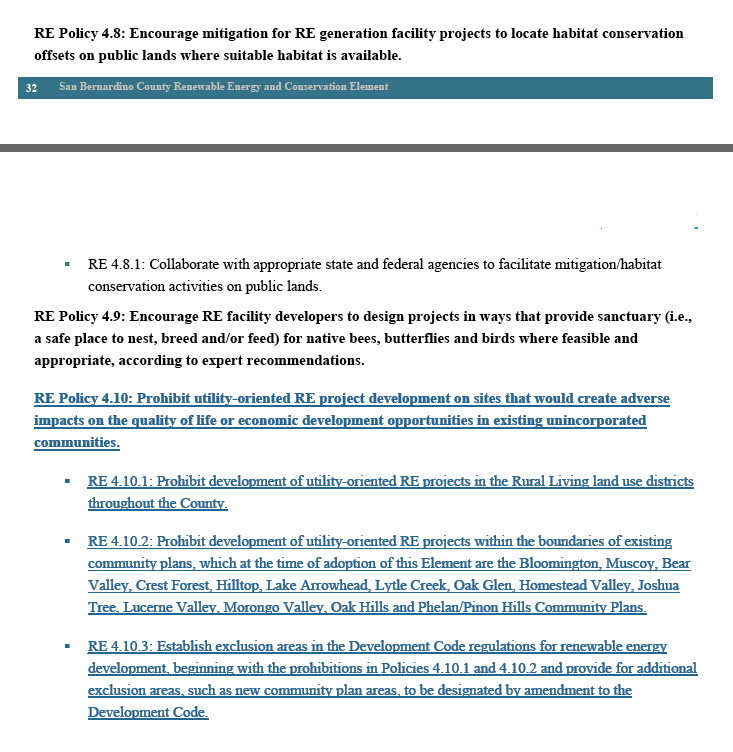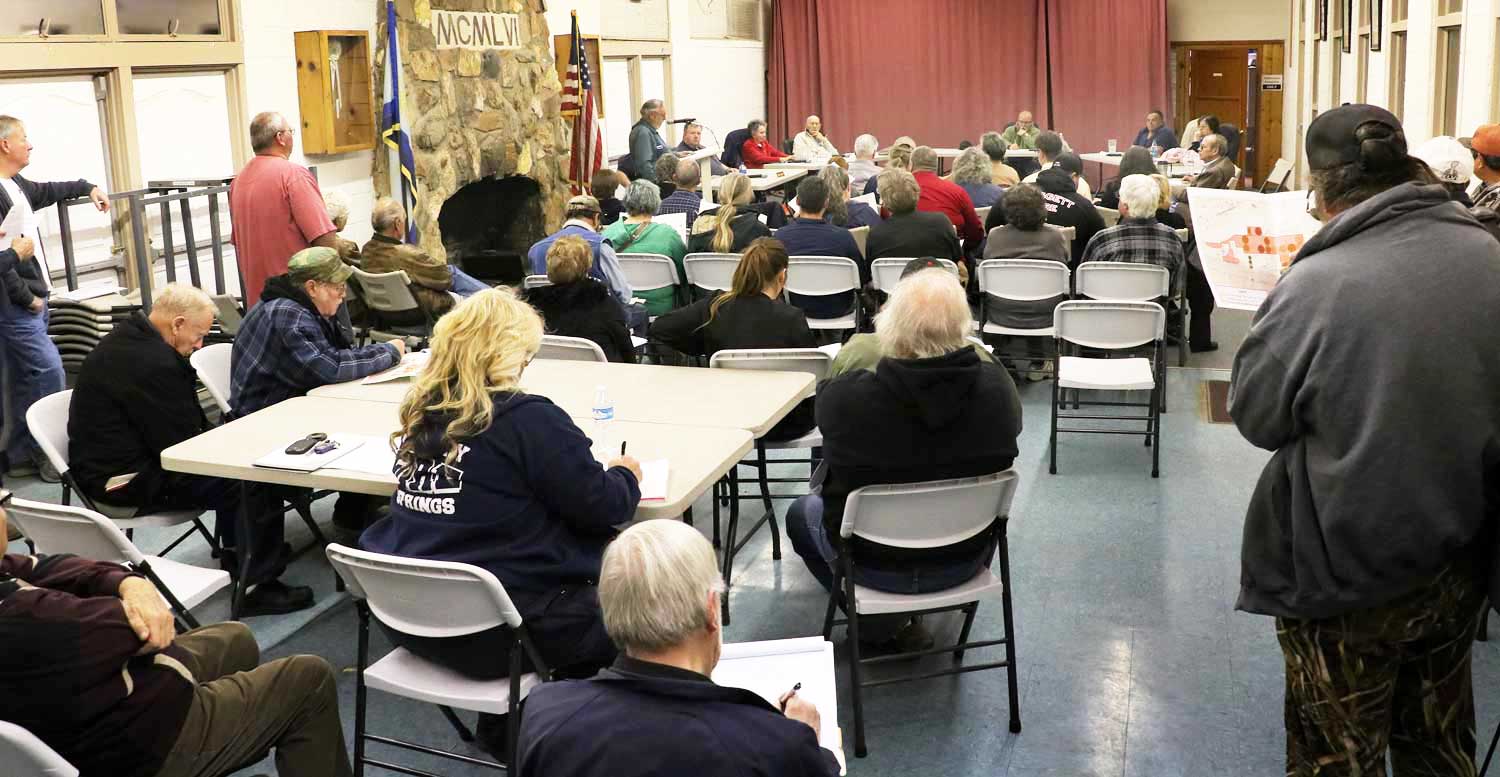Posted: February 4, 2018
Whimpy, Whimpy, Whimpy.

The Newberry Community Service District's Board of Directors held
a Special Meeting on Tuesday, January 30, 2018, that included representatives from Daggett,
Lucerne Valley, and nearly 50 local residents. Don Holland, Policy Advisor
to First District Supervisor Bob Lovingood and Field Representative Bea Lint were among
those in attendance.
The single agenda item dealt with how the CSD should handle the
proposed two photovoltaic renewable energy projects that are being planned for the Silver
Valley, a 1,200-acre project targeting Newberry Springs and a second 3,500-acre project
that would surround three sides of the Daggett Airport.
The meeting.
A number of people in the audience spoke, including Don Holland who
defended Supervisor Lovingood's record by bolstering Lovingood's voted denial of a solar
project near Baker. That project's size and location, however, had significant
cultural and natural environmental problems that legally hindered its acceptability.
Lack of county trust was the major theme that prevailed throughout
the meeting with some speakers illustrating the county's bungling of the
Soitec solar project on Mountain View Road in Newberry Springs. No one spoke
in favor of either of the two proposed solar projects during the entire meeting.
The two projects' applications, one filed late last year
and the second in January 2018, each contain many hundreds of pages filled with
data. Such extensive planning, which cost many hundreds of thousands of
dollars, is not typically expended, nor the access to thousands of acres of
land acquired, without first receiving green lights from the county's Supervisors.
So when Supervisors Ramos and Lovingood removed Policy 4.10
from the Renewable Energy and Conservation Element during the public hearing last August,
which removed residential protection from Renewable Energy (RE) developments,
a betrayal by the Supervisors was felt by residents.
Background on Zoning.
The county for the past several years has been working to revise its
General Plan with what is called the Countywide Plan. The adoption of a new General Plan
is expected late this year. As RE is one of the fastest growing
segments in the county, the county adopted the Renewable Energy and Conservation Element
(REC Element) last year which will be attached to the General Plan's revision. This
Element of the General Plan addresses how the county will manage RE development.
Under Rural Living zoning which comprises most of the county controlled
High Desert, utility-scale "Renewable Energy Generation Facilities" are allowed with a
Conditional Use Permit (CUP). As utility-scale RE development is obviously incompatible
when placed within residential communities, Policy 4.10 attempts to address this by placing
some added site exclusions upon where RE can be placed.
Third District Supervisor
Supervisor Ramos has since rebutted
the outcry over his removal vote on Policy 4.10 by spinning that he withdrew Policy 4.10
at the request of speakers at the August 8, 2017, public hearing. He claims that
speakers wanted more time to review Policy 4.10 and that the policy was not previously
reviewed by the Planning Commission.
Policy 4.10 was overwhelmingly supported by the speakers who spoke on
it at the August 8th hearing who wanted the protection for the residential stakeholders.
And, there was only four short, simple paragraphs to review.

 Policy 4.10 Note the above Policy 4.9's concern to "...provide sanctuary
(i.e., a safe place to nest, breed and/or feed) for native bees, butterflies and birds..."
Wouldn't it have been nice for Lovingood and Ramos to allow their constituents the same
consideration?
Policy 4.10 Note the above Policy 4.9's concern to "...provide sanctuary
(i.e., a safe place to nest, breed and/or feed) for native bees, butterflies and birds..."
Wouldn't it have been nice for Lovingood and Ramos to allow their constituents the same
consideration?
|
 Will Policy 4.10 be reinstated?
Will Policy 4.10 be reinstated?
Policy 4.10 was intended to be a part of the REC Element and to be
included as part of the revision of the county's General Plan. The REC Element was
approved by the Supervisors late last year without Policy 4.10. Don Holland
at the Newberry CSD meeting stated that while Policy 4.10 was removed from inclusion,
it will be going before the Planning Commission and considered for placement back
into the REC Element.
Don Holland is correct. When Policy 4.10 was removed, it was directed
by the Board to be sent to the Planning Commission, but that hasn't happened in six months.
Ted Stimpfel, a spokesperson for the Newberry Springs Community
Alliance, states that he considers the delay of Policy 4.10 going before the Planning Commission
to be a political stall. "The matter should have been immediately directed and considered
by the Planning Commission last August," states Stimpfel, "the impacted rural residents
are waiting to see what happens but the county seems to be heavily embedded with the State and
the solar developers."
There is a public movement underway to have the Planning Commission consider
Policy 4.10 this March. The Planning Commission members are appointed by, and serve
at the pleasure of, the Supervisors.
FYI.
While it is true that utility-scale RE infrastructure is not taxable under
state law, the facilities do pay Public Safety Services Impact Fees. In San Bernardino
County, this is covered under the Development Code §84.29.040 on a sliding scale. For
15-acres or greater, it is $157 per acre (only $188,400 per year for a huge 1,200-acre
facility). "Alternatively, the developer of an approved commercial solar energy generation
facility shall pay an annual public services impact fee on a per acre basis based
on a project-specific study of the project's public safety services impacts, which
study shall be paid at the developer's expense, using a consultant approved by the County."
The county's revenue is a small fraction of normal taxation.
Conflicting information from the county.
Don Holland, at the CSD meeting, also stated that the two applications
still have not been accepted by the county for processing pending additional application data
being submitted. This is interesting as the county is reported by an inside official to be
currently reviewing three responding applications that the county has solicited for preparing
the Environmental Impact Studies. Furthermore, the Land Use Services Department's own website
lists
the status of the projects as "Filed - Under Review." Either Holland is
mistaken or the county is taking exceptional steps to hyper-speed the applications'
processing time even before the applications are officially accepted.
Following the meeting, Holland has e-mailed a
letter
to the Newberry CSD Board regarding
the proposed Newberry solar project, stating that: "There are several phases of development, and
all of the individual development plans have not been submitted yet. The overall project
description noted on the web site (3,500 acres and 650 MW, with 450 MW of battery storage) is
correct."
No, Holland is incorrect. He is confusing the Daggett project with the
Newberry project.
Writing opposition letters is not enough.
Stimpfel stated at the Newberry CSD meeting that while he finds the
writing of opposition letters fine for the record, a mountain of vital legal
documentation needs to be prepared.
There is a possibility that Policy 4.10 could be reinstated into the
REC Element; however, it is more likely that the projects will go for a CUP determination.
In either case, it becomes imperative that the opposing communities have a legally strong
presentation prepared.
Submission of letters by residents is very important as they
politically establish the public's desires, but after the CSD meeting, Stimpfel
explained that at CUP hearing time, letters usually have little impact on the outcome.
The issues are matters of law and the applicant's performance. Opponents can
only stop a project based upon a compelling demonstration of the opposition's robust
legal merit.
Should they lose, the opponents can appeal to a higher authority
based solely upon the record of their previous presentation.
"We know what the problems are," Stimpfel stated,
and at the meeting, he expressed the need for the formation of a consortium to oppose
the solar projects with financial support coming from the remaining balance in the Kiewit
Pacific community trust fund that is managed by the CSD.
Stimpfel further expressed the belief that the two projects are the first
of many, that if allowed, will lead to a decrease in the community's population, force the closure
of the elementary school, the churches, and render the Newberry CSD obsolete.
After the meeting, Stimpfel also emphasized that the necessary CUP EIR rebuttals
are not just simple statements, but that they take many months to properly prepare and
legally substantiate. He stated that the CSD and the community are now losing the fight
against the solar projects by not taking immediate action. "This," said Stimpfel,
"is what happens to manipulated people who do not understand the process.
They lose."
Is the Silver Valley doomed to solar farms?
Not necessarily. The two photovoltaic projects have their own deep problems.
Their biggest hurdle may be the county's Development Code. Under §84.29.035,
Required Findings For Approval Of A Commercial Solar Energy Facility,
there are standards
that the proposed facilities simply do not meet. The county's Land Use Services Department
shouldn't be even entertaining the solar applications at the proposed sites, but they
are taking the application fees and apparently processing the applications. Like the illegal
billboards in Newberry Springs, the county continues to live up to its recognition
as one of the most corrupt counties in the nation.
Because of the Building Code's requirements and other factors, the solar
proposals appear to be beatable. The county may do the right thing and deny the
applications, but if the corruption accepts them, then the community must be ready to
advance the matter to a higher authority.
Water
The proposed Minneola Solar project in Newberry Springs call for an anticipated
half dozen water wells being drilled to cover the water needs of the numerous parcels.
Far more than that number will be needed for the much larger Daggett proposal.
The vote.
With the full Newberry Board of Directors in attendance, the
Directors moved to prepare and send a letter of solar development opposition to
Supervisor Lovingood with copies of the letter being sent to a wide spectrum of
governmental entities. Approving the letter of opposition were Directors
Robert Springer, Victoria Paulsen, Robert Shaw, and Paula Deel. Director
Larry Clark voted no.
• • •
|
A new nonpartisan association is forming to
address the Renewable Energy projects in the Silver Valley. Should you or
your organization wish to become an active participating steward in saving the
Silver Valley, please submit your name and/or that of your organization, e-mail
address and phone number to:
hdca@mail.com
|
|
• • •
Minneola Solar Project Description - (5.8MB PDF)
Daggett Solar Project Description - (192KB PDF)
• • •
Related past news blogs:
Bombshell Transformation To Hit The Silver Valley - 1/28/18
Supervisors Are Engineering Destruction Of The Desert - 1/25/18
Corrupt County Leaders Are Reshaping Newberry - 12/3/17
Lovingood Continues Damaging Votes - 11/6/17
• • •
|

